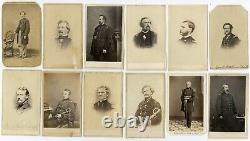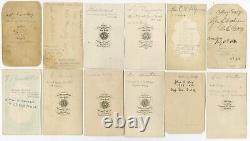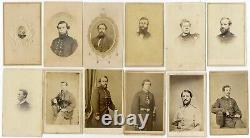Fine, Extensive Civil War Collection of 48 CDVs









Fine and extensive collection of 48 Civil War CDVs. Here is a listing of the photographers: Pine & Bell, Troy, NY (1); Rockwood, NY (1); Brady/Anthony (12); C. Fredricks, NY (6); E&HT Anthony (2); Brady, NY (4); E.
DC (1); Bogardus, NY (1); C. Black, Natchez, MS (2); L. Judkins, Haverhill, MA (1); J. (1); Hallett, NY (1); J.Morgan, Concord, NH (1); and CDVs without backmark (8). Here is a detailed description of all of the images. Pine & Bell, Troy, NY. I believe this is John Finney, Co.
Residence was not listed; Enlisted on 7/27/1864 as a Corporal. On 7/27/1864 he transferred into "H" Co. He was Mustered Out on 6/27/1865 at Washington, DC. Promotions: Private (Reduced to ranks); Corpl 8/20/1864; Sergt 10/11/1864. He also had service in: NY 74th Infantry. Edward Carlisle Boynton, US Army 11th Infantry.Residence was not listed; Enlisted on 9/23/1861 as a Captain. On 9/23/1861 he was commissioned into US Army 11th Infantry (date and method of discharge not given). Promotions: Major 3/13/1865 by Brevet. Other Information: born in Vermont; died 3/13/1893. Photographic negative by Brady's National Portrait Gallery.
Published by E&HT Anthony, NY. He was the victor at prominent battles such as Second Corinth, Stones River, and the Tullahoma Campaign, but his military career was effectively ended following his disastrous defeat at the Battle of Chickamauga in 1863. Residence was not listed; Enlisted on 4/20/1861 at New York City, NY as a 2nd Lieutenant. On 4/20/1861 he was commissioned into Unassigned NY 69th Infantry. He was Mustered Out on 8/3/1861 at New York, NY.On back of CDV is written in addition, Major AAG staff of Maj. " On back "Acting Ensign Geo. Cairo Ills, July 18th, 1862. Acting Ensign Jan 24, 1863; Appointment revoked (sick) Oct. Acting Master, 9 July, 1861.
Honorably discharged 18 September, 1865. Brady's National Portrait Gallery. Negative by Brady's National Portrait Gallery. Published by E&HT Anthony, New York. Leonidas Polk (April 10, 1806 - June 14, 1864) was a Confederate general in the Civil War who was once a planter in Maury County, Tennessee, and a second cousin of President James K. He also served as bishop of the Episcopal Diocese of Louisiana and was for that reason known as Sewanee's Fighting Bishop. He is often erroneously named Leonidas K. He had no middle name and never signed any documents as such. The errant "K" was derived from his listing in the post-bellum New Orleans press as Polk, Leon. (k) for killed in action. Polk was one of the more successful, yet controversial political generals of the war, elevated to a high military position with no prior combat experience because of his friendship with Confederate President Jefferson Davis.He fought as a corps commander in many of the major battles of the Western Theater, but is remembered more for his bitter disagreements with his immediate superior, Gen. Braxton Bragg of the Army of Tennessee, than for his success in combat.
While serving under the command of Gen. Johnston, he was killed in action in 1864 during the Atlanta Campaign. Benjamin Franklin "Frank" Cheatham (October 20, 1820 - September 4, 1886) was a Tennessee planter, California gold miner, and a general in the Confederate States Army during the Civil War. He served in the Army of Tennessee, inflicting many casualties on Sherman at Kennesaw Mountain, but taking the blame for General Schofield's escape at Spring Hill, a major factor in the Confederate defeat at Franklin. The uniform he is wearing was a fantasy Confederate uniform used by photographers in the North who didn't yet know what real Confederate general uniforms looked like. So, they just made one up. There are a few Confederate States generals in CDVs wearing the exact same uniform (with their headshots based on antebellum views).Photographic negative by Brady, published by E. General Andrew Porter (July 10, 1820 - January 3, 1872), brigadier general. He was an important staff officer under McClellan during the 1862 Peninsula Campaign, serving as the Provost Marshal of the Army of the Potomac.
Brady's National Photographic Portrait Galleries, NY. Addis, Photographer, McClees' Gallery, Washington, DC. Fitz John Porter (August 31, 1822 - May 21, 1901) was a career Army officer and a Union general during the Civil War. He is known for his performance at Second Bull Run and his subsequent court martial. Although Porter served well in the early battles of the Civil War, his military career was ruined by the controversial trial, which was called by his political rivals.
After the war, he worked for almost 25 years to restore his tarnished reputation and was finally restored to the army's roll. Brady's National Photographic Galleries, New York.
George Archibald McCall (March 16, 1802 - February 25, 1868) was an Army officer who became a brigadier general and prisoner of war during the Civil War. He was also a naturalist. Nick at top left corner. Don Carlos Buell (March 23, 1818 - November 19, 1898) was an Army officer who fought in the Seminole War, the Mexican-American War, and the Civil War.
Buell led Union armies in two great Civil War battles-Shiloh and Perryville. The nation was angry at his failure to defeat the outnumbered Confederates after Perryville, or to secure East Tennessee. Historians generally concur that he was a brave and industrious master of logistics, but was too cautious and too rigid to meet the great challenges he faced in 1862.Buell was relieved of field command in late 1862 and made no more significant military contributions. Anthony's Stereoscopic Emporium, 501 Broadway, NY. Robert Rhett (born Robert Barnwell Smith ; December 21, 1800 - September 14, 1876) was a politician who served as a deputy from South Carolina to the Provisional Confederate States Congress from 1861 to 1862, a member of the US House of Representatives from South Carolina from 1837 to 1849, and US Senator from South Carolina from 1850 to 1852. A pro-slavery extremist and an early advocate of secession, he was a Fire-Eater.
Rhett published his views through his newspaper, the Charleston Mercury. He was never a general and this image transposes his head onto a uniform. William Branford Shubrick (31 October 1790 - 27 May 1874) was an officer in the Navy. His active-duty career extended from 1806 to 1861, including service in the War of 1812 and the Mexican-American War; he was placed on the retired list in the early months of the Civil War. Rear Admiral Charles Stewart Boggs (28 January 1811 - 22 April 1888) served in the United States Navy during the Mexican-American War and the Civil War. In December 1861 Boggs was given command of the gunboat Varuna. The following April, during the Capture of New Orleans, he commanded her with distinction. In the attack of the squadron on the Mississippi forts, April 18-24...He destroyed six of the Confederate gunboats, but finally lost his own vessel, after driving his antagonist ashore in flames. When he found the Varuna sinking, he ran her ashore, tied her to the trees, and fought his guns until the water was over the guntracks. Runa was lost in the battle with 184 casualties. Receiving his Captain's commission in July 1862, during the rest of the Civil War he was commanding officer of the steam sloops Juniata and Sacramento, with the North Atlantic Blockading Squadron, the steam cruiser Connecticut in the West Indies, and had special duty at the New York Navy Yard. Photographic negative by Brady, published by E&HT Anthony.
Rear Admiral Silas Horton Stringham (7 November 1798 - 7 February 1876) was an officer of the United States Navy who saw active service during the War of 1812, the Second Barbary War, and the Mexican-American War, and who commanded the Atlantic Blockading Squadron at the beginning of the Civil War. Born in Middletown, New York, Stringham entered the Navy on 15 November 1809, aged only 11 years old, receiving promotion to the rank of midshipman on 19 June 1810 while serving under Captain John Rodgers in the frigate President. He was present during the Little Belt Affair in May 1811, and during the engagement with HMS Belvidera on 23 June 1812. Having received his commission as a lieutenant on 9 December 1814, he was assigned to the brig Spark, Captain Thomas Gamble, which was part of Stephen Decatur's squadron in the Barbary Wars, and helped to take an Algerine frigate. In early 1816, while Spark was at Gibraltar, a French brig, attempting to enter the bay in a heavy gale, capsized.Stringham and six seamen in a small boat, pulled over to the brig, and rescued five of the crew. He attempted to return to Spark, but could make no headway, so turned and pulled for the Algerian shore, but was wrecked in the heavy surf, with one of his crew and two of the Frenchmen drowned. In 1819 Stringham was serving aboard the Cyane, conveying black settlers to Liberia.
In 1821 Stringham was appointed First Lieutenant of the brig Hornet in the West Indies Squadron, and from 1825 to 1829 served at the Brooklyn Navy Yard. During the search he was transferred to the sloop Falmouth, and sent to Cartagena, finally returning to New York in 1830. Stringham was promoted to commander on 3 March 1831, and for the next five years was engaged on shore duty. For a short time afterwards he commanded the Brazil Squadron, but in 1851 took charge of the Gosport Navy Yard. Between 1852 and 1855 he commanded the Mediterranean Squadron, his flagship being the frigate Cumberland.
On the outbreak of the Civil War in April 1861, he was appointed Flag officer of the Atlantic Blockading Squadron. In August he was sent with troops under General Benjamin F.
Butler, to capture two coastal forts near Cape Hatteras. As some small compensation on 1 August 1862 he was promoted to the rank of rear admiral on the retired list. Though no longer on active duty, Stringham served as Commandant of the Boston Navy Yard, 1864-66, and as Port admiral of New York in 1870.
Rear Admiral Stringham died in Brooklyn, New York. And was buried at Green-Wood Cemetery, Brooklyn. John Bankhead Magruder (May 1, 1807 - February 18, 1871) was an American and Confederate military officer. As a major general, he received recognition for delaying the advance of McClellan's Army of the Potomac, during the Peninsula Campaign, as well as recapturing Galveston, Texas the following year. When the Civil War began in 1861, Magruder left the Union Army to accept a commission in the Confederacy. As commander of the Army of the Peninsula, he fortified the Virginia Peninsula and won the Battle of Big Bethel. In the Peninsula Campaign, he stalled McClellan's Army of the Potomac outside Yorktown, allowing Maj.Johnston to arrive with reinforcements, organize a retreat, and defend the Confederate capital, Richmond. Magruder was criticized for his leadership in battles at Savage's Station and Malvern Hill during the Seven Days Campaign.
He spent the remainder of the war administering the District of Texas, New Mexico, and Arizona and the Department of Arkansas; in his tenure, Magruder lifted the naval blockade over Galveston and recaptured the city in 1863. After surrendering the Trans-Mississippi Department in June 1865, Magruder fled to Mexico. He worked in an administrative role under Emperor Maximillian I before returning to the United States in 1867.In 1869, he embarked on a lecture tour, speaking on the Mexican monarchy. Magruder died in Houston in 1871. Franklin Buchanan (September 17, 1800 - May 11, 1874) was an officer in the United States Navy who became the only full admiral in the Confederate Navy during the Civil War. He also commanded the ironclad CSS Virginia. During the 45 years he served in the U.
Navy, Buchanan had extensive and worldwide sea duty. In 1845, at the request of the U. With the Civil War upon him, he resigned his commission on April 22, 1861, expecting his home State of Maryland to eventually secede. When that didn't happen, he tried to recall his resignation, but U. Secretary of the Navy, Gideon Welles said he did not want traitors or half-hearted patriots in his navy and refused to reinstate him.
Thus in May, 1861 he was out of the U. On September 5, 1861, Franklin Buchanan joined the Confederate Navy and was given a captain's commission. Buchanan was the captain of the CSS Virginia (formerly the USS Merrimack) during the Battle of Hampton Roads in Virginia. He climbed to the top deck of Virginia and began furiously firing toward shore with a carbine as the USS Congress was shelled. He soon was brought down by a sharpshooter's minie ball to the thigh.
He would eventually recover from his leg wound. He never did get to command Virginia against the USS Monitor.
But Buchanan had handed the United States Navy the worst defeat it would take until the Attack on Pearl Harbor. In August 1862, Buchanan was promoted to the rank of Full Admiral - the only officer so honored in the Confederate Navy - and was sent to take command of Confederate naval forces stationed at Mobile Bay, Alabama.He oversaw the construction of the ironclad CSS Tennessee whose keel was laid in October, 1862 and was on board her during the Battle of Mobile Bay with Rear Admiral David Glasgow Farragut's Union fleet on August 5, 1864. Wounded and taken prisoner, Buchanan was not exchanged until February 1865.
He was on convalescent leave until the Civil War ended a few months later. Photographic negative by Brady's National Portrait Gallery, published by E. Theodorus Bailey (April 12, 1805 - February 14, 1877) was a United States Navy officer during the Civil War. The outbreak of the Civil War brought Bailey the orders he sought. On 3 June 1861, he put the steam frigate Colorado back in commission at Boston and set sail a fortnight later to join the Gulf Blockading Squadron.
Colorado arrived at Key West on 9 July and at Fort Pickens on Santa Rosa Island off Pensacola on the 15th. There, Colorado became flagship of the Gulf Blockading Squadron on 16 July when Flag Officer William Mervine embarked. When the push to take the city went off on 24 April, Bailey commanded one of the gunboat divisions during the fight to pass Forts Jackson and St. Once that feat had been accomplished, he continued on upriver to demand the city's surrender on the 25th.
Bailey and Lieutenant George Perkins walked to city hall despite armed civilians crowding around them, shouting threats. Mayor John Monroe refused to surrender the city, but as Confederate troops had already evacuated, the Union soon occupied New Orleans. Promoted to commodore on 16 July 1862, Bailey commanded the station at Sackett's Harbor, New York, through the summer of 1862. Heading south again in November 1862, Bailey relieved Acting Rear Admiral James L. Lardner as flag officer commanding the East Gulf Blockading Squadron. He held that post until the summer of 1864 when, after a bout of yellow fever, he was transferred to duty as the commandant at the Portsmouth Navy Yard. About halfway through that assignment, he received his promotion to rear admiral on 25 July 1866. Though placed on the retired list on 10 October 1866, Rear Admiral Bailey served as the commandant at Portsmouth until the latter part of 1867.Rear Admiral Bailey died at Washington, D. Photographic negative from Brady's National Portrait Gallery, published by E. Hiram Paulding (December 11, 1797 - October 20, 1878) was a Rear Admiral in the United States Navy, who served from the War of 1812 until after the Civil War. David Hunter (July 21, 1802 - February 2, 1886) was a Union general during the Civil War. He achieved fame by his unauthorized 1862 order (immediately rescinded) emancipating slaves in three Southern states, for his leadership of United States troops during the Valley Campaigns of 1864, and as the president of the military commission trying the conspirators involved with the assassination of U.
George Brinton McClellan (December 3, 1826 - October 29, 1885) was a soldier, civil engineer, railroad executive, and politician. A graduate of West Point, McClellan served with distinction during the Mexican War. And later left the Army to work in railroads until the outbreak of the Civil War.
Early in the war, McClellan was appointed to the rank of major general and played an important role in raising a well-trained and organized army, which would become the Army of the Potomac in the Eastern Theater; he served a brief period (November 1861 to March 1862) as general-in-chief of the Union Army. Although McClellan was meticulous in his planning and preparations, these very characteristics hampered his ability to challenge aggressive opponents in a fast-moving battlefield environment.
He chronically overestimated the strength of enemy units and was reluctant to apply principles of mass, frequently leaving large portions of his army unengaged at decisive points. McClellan organized and led the Union army in the Peninsula Campaign in southeastern Virginia from March through July 1862. It was the first large-scale offensive in the Eastern Theater. Making an amphibious clockwise turning movement around the Confederate Army in northern Virginia, McClellan's forces turned west to move up the Virginia Peninsula, between the James and York Rivers landing from the Chesapeake Bay, with the Confederate capital, Richmond, as their objective. Initially, McClellan was somewhat successful against the equally cautious General Joseph E.
Johnston, but the military emergence of General Robert E. Lee to command the Army of Northern Virginia turned the subsequent Seven Days Battles into a partial Union defeat. General McClellan failed to maintain the trust of President Abraham Lincoln.
He did not trust his commander-in-chief and was privately derisive of him. He was removed from command in November after failing to decisively pursue Lee's Army following the tactically inconclusive but strategic Union victory at the Battle of Antietam outside Sharpsburg, Maryland, and never received another field command.McClellan went on to become the unsuccessful Democratic Party nominee in the 1864 presidential election against Lincoln's reelection. The effectiveness of his campaign was damaged when he repudiated his party's platform, which promised an end to the war and negotiations with the southern Confederacy. He served as the 24th Governor of New Jersey from 1878 to 1881, and eventually became a writer, and vigorously defended his Civil War conduct. Most modern authorities have assessed McClellan as a poor battlefield general. Some historians view him as a highly capable commander whose reputation suffered unfairly at the hands of pro-Lincoln partisans who made him a scapegoat for the Union's military setbacks.
After the war, subsequent commanding general and 18th President Ulysses S. Grant was asked for his opinion of McClellan as a general; he replied, McClellan is to me one of the mysteries of the war. On back is written 7th New Jersey Group? This is a previous owner's note. Photographic negative by Brady's National Photographic Portrait Gallery, published by E.
Leonidas Polk (April 10, 1806 - June 14, 1864) was a planter in Maury County, Tennessee, and a second cousin of President James K. He served as bishop of the Episcopal Diocese of Louisiana. He resigned his ecclesiastical position to become a major general in the Confederate army (called "Sewanee's Fighting Bishop"). His official portrait at the University depicts him dressed as a bishop with his army uniform hanging nearby. (k)", signifying "killed in action.Polk was one of the more notable, yet controversial, political generals of the war. Recognizing his indispensable familiarity with the Mississippi Valley, Confederate President Jefferson Davis commissioned his elevation to a high military position regardless of his lack of prior combat experience. He commanded troops in the Battle of Shiloh, the Battle of Perryville, the Battle of Stones River, the Tullahoma Campaign, the Battle of Chickamauga, the Chattanooga Campaign, and the Atlanta Campaign.
He is remembered for his bitter disagreements with his immediate superior, the likewise-controversial General Braxton Bragg of the Army of Tennessee, and for his general lack of success in combat. While serving under the command of General Joseph E. Photographic negative by Brady's National Portrait Gallery, published by E&HT Anthony. Benjamin Franklin Butler (November 5, 1818 - January 11, 1893) was a major general of the Union Army, politician, lawyer and businessman from Massachusetts. Born in New Hampshire and raised in Lowell, Massachusetts, Butler is best known as a political major general of the Union Army during the Civil War, and for his leadership role in the impeachment of President Andrew Johnson. He was a colorful and often controversial figure on the national stage and in the Massachusetts political scene, during his one term as Governor. Butler, a successful trial lawyer, served in the Massachusetts legislature as an antiwar Democrat and as an officer in the state militia.Early in the Civil War he joined the Union Army, where he was noted for his lack of military skill, and his controversial command of New Orleans, which brought him wide dislike in the South and the "Beast" epithet. He helped create the legal idea of effectively freeing fugitive slaves by designating them as contraband of war in service of military objectives, which led to a political groundswell in the North which included general emancipation and the end of slavery as official war goals.
His commands were marred by financial and logistical dealings across enemy lines, some of which probably took place with his knowledge and to his financial benefit. Butler was dismissed from the Union Army after his failures in the First Battle of Fort Fisher, but soon won election to the US House of Representatives from Massachusetts. As a Radical Republican he opposed President Johnson's Reconstruction agenda, and was the House's lead manager in the Johnson impeachment proceedings. As Chairman of the House Committee on Reconstruction, Butler authored the Ku Klux Klan Act of 1871 and coauthored the landmark Civil Rights Act of 1875.
In Massachusetts, Butler was often at odds with more conservative members of the political establishment over matters of both style and substance. Feuds with Republican politicians led to his being denied several nominations for the governorship between 1858 and 1880. Returning to the Democratic fold, he won the governorship in the 1882 election with Democratic and Greenback Party support. He ran for President on the Greenback ticket in 1884. Gen Winfield Scott at West Point, NY June 10, 1862. Brady's National Photographic Portrait Galleries, NY and Washington, DC. Samuel Peter Heintzelman (September 30, 1805 - May 1, 1880) was a US Army general. He served in the Seminole War, the Mexican-American War, the Yuma War and the Cortina Troubles. During the Civil War he was a prominent figure in the early months of the war rising to the command of a corps. Erasmus Darwin Keyes (May 29, 1810 - October 14, 1895) was a businessman, banker, and military general, noted for leading the IV Corps of the Army of the Potomac during the first half of the Civil War. John Ellis Wool (February 20, 1784 - November 10, 1869) was an officer in the Army during three consecutive wars: the War of 1812, the Mexican-American War and the Civil War. By the time of the Mexican-American War, he was widely considered one of the most capable officers in the army and a superb organizer. He was one of the four general officers of the United States Army in 1861, and was the one who had the most service. When the war began, Wool, age 77 and a brigadier general for 20 years, commanded the Department of the East. He was the oldest general on either side of the war. Ormsby MacKnight (or McKnight) Mitchel (August 28, 1810, or possibly 1809, - October 30, 1862) was an American astronomer and major general in the Civil War. A multi-talented man, he was also an attorney, surveyor, professor, and publisher. He is notable for publishing the first magazine in the United States devoted to astronomy.Known in the Union Army as "Old Stars, " he is best known for ordering the raid that became famous as the Great Locomotive Chase during the American Civil War. John Adams Dix (July 24, 1798 - April 21, 1879) was Secretary of the Treasury, Governor of New York and Union major general during the Civil War. Residence Melrose MA; a 43 year-old Bookbinder. Enlisted on 7/22/1861 as a Captain.
On 8/21/1861 he was commissioned into "K" Co. He was Mustered Out on 8/3/1864 at Boston, MA. Unidentified soldier with curious tie. Unidentified Veterans Reserve Corps soldier.
Brady's National Photographic Portrait Galleries, Washington. On back it looks like "Little, Boston" is written. Thank you for your participation. This item is in the category "Collectibles\Militaria\Civil War (1861-65)\Original Period Items\Photographs". The seller is "ravenview" and is located in this country: US. This item can be shipped worldwide.
